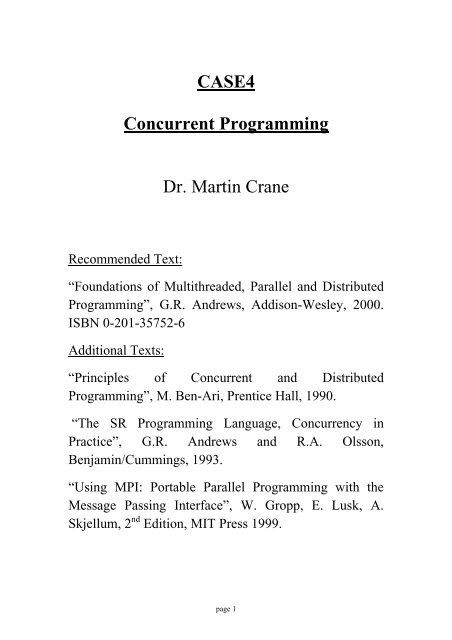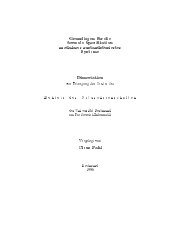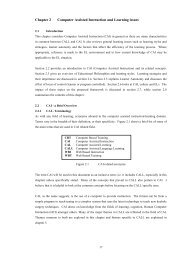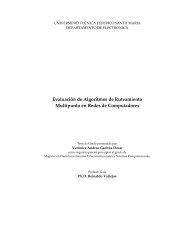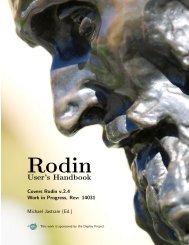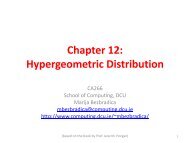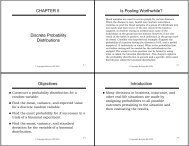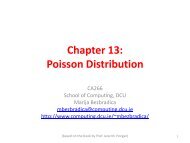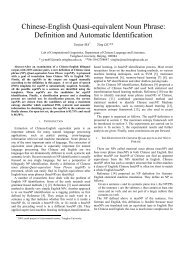CA4 Introduction to Parallel and Distributed Computing
CA4 Introduction to Parallel and Distributed Computing
CA4 Introduction to Parallel and Distributed Computing
Create successful ePaper yourself
Turn your PDF publications into a flip-book with our unique Google optimized e-Paper software.
CASE4<br />
Concurrent Programming<br />
Recommended Text:<br />
Dr. Martin Crane<br />
“Foundations of Multithreaded, <strong>Parallel</strong> <strong>and</strong> <strong>Distributed</strong><br />
Programming”, G.R. Andrews, Addison-Wesley, 2000.<br />
ISBN 0-201-35752-6<br />
Additional Texts:<br />
“Principles of Concurrent <strong>and</strong> <strong>Distributed</strong><br />
Programming”, M. Ben-Ari, Prentice Hall, 1990.<br />
“The SR Programming Language, Concurrency in<br />
Practice”, G.R. Andrews <strong>and</strong> R.A. Olsson,<br />
Benjamin/Cummings, 1993.<br />
“Using MPI: Portable <strong>Parallel</strong> Programming with the<br />
Message Passing Interface”, W. Gropp, E. Lusk, A.<br />
Skjellum, 2 nd Edition, MIT Press 1999.<br />
page 1
Course Outline<br />
• <strong>Introduction</strong> <strong>to</strong> Concurrent Processing<br />
• Critical Sections <strong>and</strong> Mutual Exclusion<br />
• Semaphores<br />
• Moni<strong>to</strong>rs<br />
• Message Passing (Java <strong>and</strong> MPI)<br />
• Remote Procedure Calls (RPC)<br />
• Rendezvous<br />
• Languages for Concurrent Processing (SR, Java,<br />
Linda)<br />
• Load Balancing <strong>and</strong> Resource Allocation<br />
• Fault Tolerance<br />
page 2
<strong>Parallel</strong> vs. <strong>Distributed</strong> <strong>Computing</strong><br />
The individual processors of a distributed system<br />
are physically distributed (loosely coupled), whereas<br />
parallel systems are “in the same box” (tightly coupled).<br />
Both are examples of multiprocessing, but distributed<br />
computing introduces extra issues.<br />
<strong>Parallel</strong> <strong>Computing</strong><br />
<strong>Distributed</strong> <strong>Computing</strong><br />
Why bother?<br />
Concurrent <strong>Computing</strong><br />
The advantages of concurrent processing are:<br />
1) Faster processing<br />
2) Better resource usage<br />
3) Fault <strong>to</strong>lerance<br />
page 3
Types of Concurrent Processing<br />
Overlapping I/O <strong>and</strong> Processing<br />
Multi-Programming<br />
I/O<br />
Active<br />
Main<br />
Waiting<br />
One processor time-slices between several<br />
programs.<br />
P1 I/O P2 I/O P1 I/O<br />
page 4<br />
I/O<br />
P2<br />
P1<br />
Active<br />
Waiting
Multi-tasking<br />
This is a generalisation of the multi-programming<br />
concept. Each program is decomposed in<strong>to</strong> a set of<br />
concurrent tasks. The processor time-slices between all<br />
the tasks.<br />
Multi-Processing<br />
The set of concurrent tasks are processed by a set of<br />
interconnected processors. Each processor may have<br />
more than one task allocated <strong>to</strong> it, <strong>and</strong> may time-slice<br />
between its allocated tasks.<br />
Applications of Concurrent Processing<br />
Predictive Modelling <strong>and</strong> Simulation<br />
Weather forecasting, Oceanography <strong>and</strong> astrophysics,<br />
Socioeconomics <strong>and</strong> governmental use, etc.<br />
Engineering Design <strong>and</strong> Au<strong>to</strong>mation<br />
Finite-element analysis, Computational Aerodynamics,<br />
Artificial Intelligence (Image processing, pattern<br />
recognition, speech underst<strong>and</strong>ing, expert systems, etc.),<br />
Remote Sensing, etc.<br />
page 5
Energy Resource Exploration<br />
Seismic Exploration, Reservoir Modelling, Plasma<br />
Fusion Power, Nuclear Reac<strong>to</strong>r Safety, etc.<br />
Medical<br />
Computer-assisted Tomography.<br />
Military<br />
Weapons Research, Intelligence gathering surveillance,<br />
etc.<br />
Research<br />
Computational Chemistry <strong>and</strong> Physics, Genome<br />
Research, VLSI analysis <strong>and</strong> design, etc.<br />
<strong>Parallel</strong> Speed-up<br />
Minsky’s Conjecture<br />
Minsky argued that algorithms such as binary<br />
search, branch <strong>and</strong> bound, etc. would give the best speedup.<br />
All processors would be used in the 1st iteration, half<br />
in the 2nd, <strong>and</strong> so, giving a speed-up of log 2 P .<br />
page 6
Amdahl’s Law<br />
Gene Amdahl divided a program in<strong>to</strong> 2 sections,<br />
one that is inherently serial <strong>and</strong> the other which can be<br />
parallel. Let α be the fraction of the program which is<br />
inherently serial. Then,<br />
T(<br />
α + ( 1 − α)<br />
) P 1<br />
Speed − up, S =<br />
= ≤ , ∀ P > 1<br />
( − )<br />
T<br />
⎛ 1 α ( P<br />
+<br />
⎞ 1+ −1)<br />
α α<br />
⎜α<br />
⎟<br />
⎝ P ⎠<br />
If α = 5%, then S ≤ 20.<br />
Graph of S against 1- α for different α<br />
page 7
Taking Amdahl’s law again:<br />
( α + ( 1−<br />
α ) ) 1<br />
=<br />
( 1−<br />
α ) ( 1−<br />
α )<br />
T<br />
Speed − up,<br />
S =<br />
, ∀P<br />
> 1<br />
⎛ ⎞<br />
T⎜α<br />
+ ⎟ α +<br />
⎝ P ⎠ P<br />
for α =1 (wholly serial problems) S=1/α =1<br />
for α =0 (wholly parallel problems) S=P<br />
2<br />
for α =0.5, S= , as P becomes large S approaches 2<br />
1<br />
1+<br />
P<br />
Graph of S against 1- α for different P<br />
The S<strong>and</strong>ia Experiments<br />
page 8
The Karp prize was established for the first program<br />
<strong>to</strong> achieve a speed-up of 200 or better. In 1988, a team<br />
from S<strong>and</strong>ia labora<strong>to</strong>ries reported a speed-up of over<br />
1,000 on a 1,024 processor system on three different<br />
problems.<br />
How?<br />
Moler’s Law<br />
An implicit assumption of Amdahl’s Law is that the<br />
fraction of the program which is inherently serial, α, is<br />
independent of the size of the program. The S<strong>and</strong>ia<br />
experiments showed this <strong>to</strong> be false. As the problem size<br />
increased the inherently serial parts of a program<br />
remained the same or increased at a slower rate than the<br />
problem size. So Amdahl’s law should be<br />
S ≤<br />
( n)<br />
1<br />
α<br />
so as the problem size, n, increases, α( n ) decreases<br />
<strong>and</strong> S increases.<br />
For example, certain problems demonstrate increased<br />
performance by increasing the problem size. For<br />
example:<br />
2D Grid Calculations: 85 seconds 85%<br />
Serial fraction: 15 seconds 15%<br />
page 9
We can increase the problem size by doubling the grid<br />
dimensions <strong>and</strong> halving the time step. This results in four<br />
times the number of grid points <strong>and</strong> twice the number of<br />
time steps. The timings then look like:<br />
2D Grid Calculations 680 seconds 97.84%<br />
Serial fraction 15 seconds 2.16%<br />
Problems that increase the percentage of parallel time<br />
with their size are more scalable than problems with a<br />
fixed percentage of parallel time<br />
Moler defined an efficient parallel algorithm as one<br />
where α( n) → 0 as n → ∞ (Moler’s law).<br />
Sullivan’s First Theorem<br />
The speed-up of a program is min ( P, C ) , where P is<br />
the number of processors <strong>and</strong> C is the concurrency of the<br />
program.<br />
Execution graph<br />
(directed acyclic graph)<br />
If N is the number of operations in the execution<br />
graph, <strong>and</strong> D is the longest path through the graph then<br />
the concurrency C = N/D.<br />
The maximum speed-up is a property of the<br />
structure of the parallel program.<br />
page 10
Architectural Classification Schemes<br />
Flynn’s Classification<br />
Bases on multiplicity of instruction streams <strong>and</strong><br />
data streams.<br />
SISD Single Instruction Single Data<br />
CU PU MM<br />
(old but still common)<br />
SIMD Single Instruction Multiple Data Array<br />
processors<br />
CU<br />
IS<br />
IS<br />
IS<br />
IS DS<br />
PU<br />
PU<br />
PU<br />
DS<br />
DS<br />
DS<br />
MM<br />
MM<br />
MM<br />
(most modern especially those with Graphics)<br />
MISD Multiple Instruction Single Data<br />
Some say this is impractical - no MISD machine exists.<br />
Maybe multiple Cryp<strong>to</strong> Algorithms on a single message?<br />
page 11
CU<br />
CU<br />
CU<br />
IS<br />
IS<br />
IS<br />
PU<br />
PU<br />
PU<br />
MM MM MM<br />
MIMD Multiple Instruction Multiple Data<br />
Most modern supercomputers are MIMD with SIMD<br />
subcomponents for specialised tasks.<br />
CU<br />
CU<br />
CU<br />
IS<br />
IS<br />
IS<br />
PU<br />
PU<br />
PU<br />
DS<br />
DS<br />
DS<br />
page 12<br />
DS<br />
DS<br />
IS IS IS<br />
MM<br />
MM<br />
MM<br />
IS<br />
IS<br />
IS
Processor Topologies<br />
Farm (Star)<br />
Ring<br />
Used in image processing applications, or anything<br />
which uses a nearest-neighbour opera<strong>to</strong>r.<br />
Mesh<br />
Image processing, finite-element analysis, nearestneighbour<br />
operations.<br />
page 13
Torus<br />
A variant of the mesh.<br />
Hypercube<br />
A structure with the minimum diameter property.<br />
3-d hypercube<br />
4-d hypercube<br />
A Model of Concurrent Programming<br />
page 14
A concurrent program is the interleaving of sets of<br />
sequential a<strong>to</strong>mic instructions.<br />
A concurrent program can be considered as a set of<br />
interacting sequential processes. These sequential<br />
processes execute at the same time, on the same or<br />
different processors. The processes are said <strong>to</strong> be<br />
interleaved, that is at any given time each processor is<br />
executing one of the instructions of the sequential<br />
processes. The relative rate at which the instructions of<br />
each process are executed is not important.<br />
Each sequential process consists of a series of<br />
a<strong>to</strong>mic instructions. An a<strong>to</strong>mic instruction is an<br />
instruction that once it starts, proceeds <strong>to</strong> completion<br />
without interruption. Different processors have different<br />
a<strong>to</strong>mic instructions , <strong>and</strong> this can have a big effect.<br />
N : Integer := 0;<br />
Task body P1 is<br />
begin<br />
N := N + 1;<br />
end P1;<br />
Task body P2 is<br />
begin<br />
N := N + 1;<br />
end P2;<br />
If the processor includes instructions like INC then<br />
this program will be correct no matter which instruction<br />
page 15
is executed first. But if all arithmetic must be performed<br />
in registers then following interleaving does not produce<br />
the desired results.<br />
P1: load reg, N<br />
P2: load reg, N<br />
P1: add reg, #1<br />
P2: add reg, #1<br />
P1: s<strong>to</strong>re reg, N<br />
P2: s<strong>to</strong>re reg, N<br />
A concurrent program must be correct under all<br />
possible interleavings.<br />
Correctness<br />
If P( a) r is a property of the input (pre-condition),<br />
r r<br />
<strong>and</strong> Qab , is a property of the input <strong>and</strong> output<br />
( )<br />
(post-condition), then correctness is defined as:<br />
Partial correctness<br />
r r r r r<br />
Pa ( ) ∧terminates Prog ( ab , ) ⇒Qab<br />
,<br />
( ( ) ) ( )<br />
Total correctness<br />
r<br />
Pa ( ) ⇒<br />
r r<br />
terminates Prog ( ab , )<br />
r r<br />
∧Qab<br />
,<br />
( ( ) ( ) )<br />
Totally correct programs terminate. A <strong>to</strong>tally correct<br />
specification of the incrementing tasks is:<br />
page 16
a∈N ⇒ ( terminates( INC ( a, a) ∧ a = a+<br />
1 ) )<br />
There are 2 types of correctness properties:<br />
Safety properties These must always be true.<br />
Mutual exclusion Two processes must not<br />
interleave certain sequences of<br />
instructions.<br />
Absence of deadlock Deadlock is when a<br />
non-terminating system cannot<br />
respond <strong>to</strong> any signal.<br />
Liveness properties These must eventually be true.<br />
Absence of starvation Information sent is delivered.<br />
Fairness That any contention must be<br />
resolved.<br />
There 4 different way <strong>to</strong> specify fairness.<br />
Weak Fairness If a process continuously makes a<br />
request, eventually it will be granted.<br />
Strong fairness If a process makes a request infinitely<br />
often, eventually it will be granted.<br />
Linear waiting If a process makes a request, it will<br />
be granted before any other process<br />
page 17
is granted the request more than<br />
once.<br />
FIFO If a process makes a request, it will<br />
be granted before any other process<br />
makes a later request.<br />
Mutual Exclusion<br />
A concurrent program must be correct in all<br />
allowable interleavings. Therefore there must be some<br />
sections of the different processes which cannot be<br />
allowed <strong>to</strong> be interleaved. These are called critical<br />
sections.<br />
do true -><br />
Non_Critical_Section<br />
Pre_pro<strong>to</strong>col<br />
Critical_Section<br />
Post_pro<strong>to</strong>col<br />
od<br />
page 18
First proposed solution<br />
var Turn: int := 1;<br />
process P1<br />
do true -><br />
Non_Critical_Section<br />
do Turn != 1 -><br />
od<br />
Critical_Section<br />
Turn := 2<br />
od<br />
end<br />
process P2<br />
do true -><br />
Non_Critical_Section<br />
do Turn != 2 -><br />
od<br />
Critical_Section<br />
Turn := 1<br />
od<br />
end<br />
This solution satisfies mutual exclusion.<br />
This solution cannot deadlock, since both processes<br />
would have <strong>to</strong> loop on the test on Turn infinitely <strong>and</strong> fail.<br />
This would imply Turn = 1 <strong>and</strong> Turn = 2 at the same<br />
time.<br />
page 19
There is no starvation. This would require one task<br />
<strong>to</strong> execute its critical section infinitely often <strong>and</strong> the other<br />
task <strong>to</strong> be stuck in its pre-pro<strong>to</strong>col.<br />
However this solution can fail in the absence of<br />
contention. If one process halts in its critical section the<br />
other process will always fail in its pre-pro<strong>to</strong>col. Even if<br />
the processes are guaranteed not <strong>to</strong> halt, both processes<br />
are forced <strong>to</strong> execute at the same rate. This, in general, is<br />
not acceptable.<br />
Second proposed solution<br />
The first attempt failed because both processes<br />
shared the same variable.<br />
var C1:int := 1<br />
var C2:int := 1<br />
process P1<br />
do true -><br />
Non_Critical_Section<br />
do C2 != 1 -><br />
od<br />
C1 := 0<br />
Critical_Section<br />
C1 := 1<br />
od<br />
end<br />
page 20
process P2<br />
do true -><br />
Non_Critical_Section<br />
do C1 != 1 -><br />
od<br />
C2 := 0<br />
Critical_Section<br />
C2 := 1<br />
od<br />
end<br />
This unfortunately violates the mutual exclusion<br />
requirement. To prove this we need <strong>to</strong> find only one<br />
interleaving which allows P1 <strong>and</strong> P2 in<strong>to</strong> their critical<br />
section simultaneously. Starting from the initial state, we<br />
have:<br />
P1 checks C2 <strong>and</strong> finds C2 = 1.<br />
P2 checks C1 <strong>and</strong> finds C1 = 1.<br />
P1 sets C1 = 0.<br />
P2 sets C2 = 0.<br />
P1 enters its critical section.<br />
P2 enters its critical section. QED<br />
page 21
Third proposed solution<br />
The problem with the last attempt is that once the<br />
pre-pro<strong>to</strong>col loop is completed you cannot s<strong>to</strong>p a process<br />
from entering its critical section. So the pre-pro<strong>to</strong>col loop<br />
should be considered as part of the critical section.<br />
var C1:int := 1<br />
var C2:int := 1<br />
process P1<br />
do true -><br />
Non_Critical_Section # a1<br />
C1 := 0 # b1<br />
do C2 != 1 -> # c1<br />
od<br />
Critical_Section # d1<br />
C1 := 1 # e1<br />
od<br />
end<br />
process P2<br />
do true -><br />
Non_Critical_Section # a2<br />
C2 := 0 # b2<br />
do C1 != 1 -> # c2<br />
od<br />
Critical_Section # d2<br />
C2 := 1 # e2<br />
od<br />
end<br />
page 22
We can prove that the mutual exclusion property is<br />
valid. To do this we need <strong>to</strong> prove that the following<br />
equations are invariants.<br />
C1= 0 ≡ at( c1) ∨at( d1) ∨at( e1)<br />
− eqn 1<br />
C2 = 0 ≡ atc ( 2) ∨atd ( 2) ∨ate ( 2) −eqn<br />
2<br />
¬ at( d1) ∧at( d2)<br />
−eqn<br />
3<br />
( )<br />
at(x) ⇒ x is the next instruction <strong>to</strong> be executed in<br />
that process.<br />
Eqn 1 is initially true. Only the b1→c1 <strong>and</strong> e1→a1<br />
transitions can affect its truth. But each of these<br />
transitions also changes the value of C1.<br />
A similar proof is true for eqn 2.<br />
Eqn 3 is initially true, <strong>and</strong> can only be made false by<br />
a c2→d2 transition while at(d1) is true. But by eqn 1,<br />
at(d1)⇒C1=0, so c2→d2 cannot occur since this<br />
requires C1=1. Similar proof for process P2.<br />
Fourth proposed solution<br />
The problem with the last proposed solution was<br />
that once a process indicated its intention <strong>to</strong> enter its<br />
critical section, it also insisted on entering its critical<br />
section. What we need is some way for a process <strong>to</strong><br />
relinquish its attempt if it fails <strong>to</strong> gain immediate access<br />
<strong>to</strong> its critical section, <strong>and</strong> try again.<br />
page 23
var C1:int := 1<br />
var C2:int := 1<br />
process P1<br />
do true -><br />
Non_Critical_Section<br />
C1 := 0<br />
do true -><br />
if C2 = 1 -> exit fi<br />
C1 :=1<br />
C1 := 0<br />
od<br />
Critical_Section<br />
C1 := 1<br />
od<br />
end<br />
process P2<br />
do true -><br />
Non_Critical_Section<br />
C2 := 0<br />
do true -><br />
if C1 = 1 -> exit fi<br />
C2 :=1<br />
C2 := 0<br />
od<br />
Critical_Section<br />
C2 := 1<br />
od<br />
end<br />
This proposal has two drawbacks.<br />
page 24
1) A process can be starved. You can find an<br />
interleaving in which a process never gets <strong>to</strong> enter<br />
its critical section.<br />
2) The program can livelock. This is a form of<br />
deadlock. In deadlock there is no possible<br />
interleaving which allows the processes <strong>to</strong> enter<br />
their critical sections. In livelock, some interleaving<br />
succeed, but there sequences which do not succeed.<br />
Dekker’s Algorithm<br />
This is a combinations of the first <strong>and</strong> fourth<br />
proposals. The first proposal explicitly passed the right <strong>to</strong><br />
enter the critical sections between the processes, whereas<br />
the fourth proposal had its own variable <strong>to</strong> prevent<br />
problems in the absence of contention. In Dekker’s<br />
algorithm the right <strong>to</strong> insist on entering a critical section<br />
is explicitly passed between processes.<br />
var C1:int := 1<br />
var C2:int := 1<br />
var Turn:int := 1<br />
page 25
process P1<br />
do true -><br />
Non_Critical_Section<br />
C1 := 0<br />
do true -><br />
if C2 = 1 -> exit fi<br />
if Turn = 2 -><br />
C1 := 1<br />
do Turn != 1 -> od<br />
C1 := 0<br />
fi<br />
od<br />
Critical_Section<br />
C1 := 1<br />
Turn := 2<br />
od<br />
end<br />
process P2<br />
do true -><br />
Non_Critical_Section<br />
C2 := 0<br />
do true -><br />
if C1 = 1 -> exit fi<br />
if Turn = 1 -><br />
C2 := 1<br />
do Turn != 2 -> od<br />
C2 := 0<br />
fi<br />
od<br />
Critical_Section<br />
C2 := 1<br />
Turn := 1<br />
page 26
od<br />
end<br />
This is a solution for mutual exclusion for 2<br />
processes.<br />
Mutual Exclusion for N Processes<br />
There are many N process mutual exclusion<br />
algorithms; all complicated <strong>and</strong> relatively slow <strong>to</strong> other<br />
methods. One such algorithm is the Bakery Algorithm.<br />
The idea is that each process takes a numbered ticket<br />
(whose value constantly increases) when it want <strong>to</strong> enter<br />
its critical section. The process with the lowest current<br />
ticket gets <strong>to</strong> enter its critical section.<br />
var Choosing: [N] int<br />
var Number: [N] int<br />
# Choosing <strong>and</strong> Number arrays initialised <strong>to</strong> zero<br />
process P(i:int)<br />
do true -><br />
Non_Critical_Section<br />
Choosing [i] := 1<br />
Number [i] := 1 + max (Number)<br />
Choosing := 0<br />
fa j := 1 <strong>to</strong> N -><br />
if j != i -><br />
page 27
fi<br />
do Choosing [ j] != 0 -> od<br />
do true -><br />
if (Number [ j] = 0) or<br />
(Number [i] < Number [ j]) or<br />
((Number [i] = Number [ j]) <strong>and</strong><br />
(i < j)) -><br />
exit<br />
fi<br />
od<br />
af<br />
Critical_Section<br />
Number [i] := 0<br />
od<br />
end<br />
The bakery algorithm is not practical because:<br />
a) the ticket numbers will be unbounded if some<br />
process is always in its critical section, <strong>and</strong><br />
b) even in the absence of contention it is very<br />
inefficient as each process must query the other<br />
processes for their ticket number.<br />
page 28
Hardware-Assisted Mutual Exclusion<br />
If the a<strong>to</strong>mic instructions available allow a load <strong>and</strong><br />
s<strong>to</strong>re in a single a<strong>to</strong>mic instruction all out problems<br />
disappear. For example if there is an a<strong>to</strong>mic test <strong>and</strong> set<br />
instruction equivalent <strong>to</strong> li := C; C := 1 in one<br />
instruction, then we could have mutual exclusion as<br />
follows.<br />
var C:int := 0<br />
process P<br />
var li:int<br />
do true -><br />
Non_Critical_Section<br />
do li != 0 -> test_<strong>and</strong>_set (li) od<br />
Critical_Section<br />
C := 0<br />
od<br />
end<br />
A similar solution exists with a<strong>to</strong>mic exchange<br />
instructions.<br />
page 29


